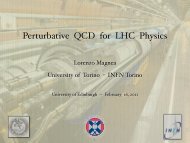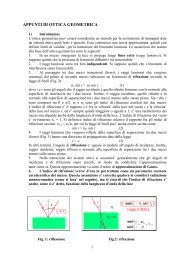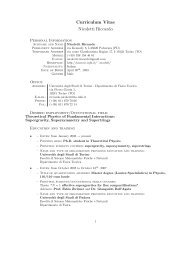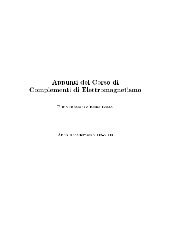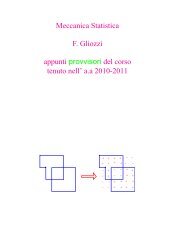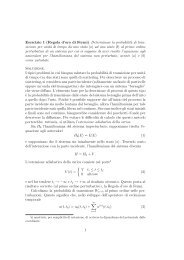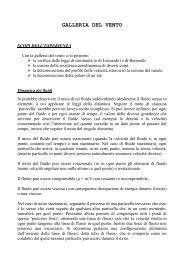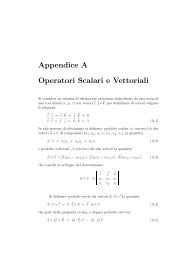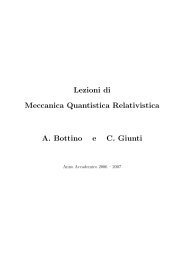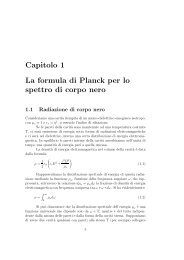Inverse energy cascade in two-dimensional turbulence - INFN
Inverse energy cascade in two-dimensional turbulence - INFN
Inverse energy cascade in two-dimensional turbulence - INFN
Create successful ePaper yourself
Turn your PDF publications into a flip-book with our unique Google optimized e-Paper software.
<strong>Inverse</strong> <strong>energy</strong> <strong>cascade</strong> <strong>in</strong> <strong>two</strong>-<strong>dimensional</strong> <strong>turbulence</strong>: Deviations from Gaussian behaviorG. Boffetta, 1 A. Celani, 1,2 and M. Vergassola 21 Dipartimento di Fisica Generale, Università di Tor<strong>in</strong>o, and INFM, Unità di Tor<strong>in</strong>o Università, I-10126 Tor<strong>in</strong>o, Italy2 CNRS, Observatoire de la Côte d’Azur, Boîte Postale 4229, 06304 Nice Cedex 4, FranceReceived 9 June 1999High-resolution numerical simulations of stationary <strong>in</strong>verse <strong>energy</strong> <strong>cascade</strong> <strong>in</strong> <strong>two</strong>-<strong>dimensional</strong> <strong>turbulence</strong>are presented. Deviations from Gaussian behavior of velocity differences statistics are quantitatively <strong>in</strong>vestigated.The level of statistical convergence is pushed enough to permit reliable measurement of the asymmetries<strong>in</strong> the probability distribution functions of longitud<strong>in</strong>al <strong>in</strong>crements and odd-order moments, which br<strong>in</strong>g thesignature of the <strong>in</strong>verse <strong>energy</strong> flux. No measurable <strong>in</strong>termittency corrections could be found <strong>in</strong> their scal<strong>in</strong>glaws. The seventh order skewness <strong>in</strong>creases by almost <strong>two</strong> orders of magnitude with respect to the third, thusbecom<strong>in</strong>g of order unity.PACS numbers: 47.10.g, 05.40.a, 47.27.iRAPID COMMUNICATIONSPHYSICAL REVIEW E VOLUME 61, NUMBER 1JANUARY 2000The <strong>in</strong>verse <strong>energy</strong> <strong>cascade</strong> <strong>in</strong> <strong>two</strong>-<strong>dimensional</strong> Navier-Stokes <strong>turbulence</strong> is one of the most important phenomena <strong>in</strong>fluid dynamics. In agreement with the remarkable predictionby Kraichnan <strong>in</strong> 1967 1, the coupled constra<strong>in</strong>ts of <strong>energy</strong>and enstrophy conservation make the <strong>energy</strong> <strong>in</strong>jected <strong>in</strong>to thesystem flow toward the large scales. This is a basic differencewith respect to 3D <strong>turbulence</strong>, where <strong>energy</strong> flows towardsmall scales <strong>in</strong> a direct <strong>cascade</strong>. The dynamical processof structur<strong>in</strong>g and organization of the large scales by the<strong>in</strong>verse <strong>cascade</strong> is also of great <strong>in</strong>terest for geophysical fluiddynamics. First numerical and experimental observations ofthe <strong>in</strong>verse <strong>cascade</strong> and the ensu<strong>in</strong>g Kolmogorov <strong>energy</strong>spectrum were obta<strong>in</strong>ed <strong>in</strong> 2–9. The important po<strong>in</strong>t foreseen<strong>in</strong> 4 is that the smallness of the skewness suggests that<strong>in</strong>termittency might be weak. This conjecture was later supportedby numerical simulations 10,11 and experiments12: scal<strong>in</strong>g laws are compatible with <strong>dimensional</strong> predictionsand both transversal and longitud<strong>in</strong>al velocity probabilitydistribution functions PDF’s look not far from Gaussian.The evidence stemm<strong>in</strong>g from experiments andsimulations is that the <strong>in</strong>verse transfer takes place via cluster<strong>in</strong>gof small-scale equal sign vortices. Strong deviationsfrom Gaussianity appear if the system has a f<strong>in</strong>ite size andfriction extract<strong>in</strong>g the <strong>energy</strong> from the large scales is smallor absent. A pile-up of <strong>energy</strong> ak<strong>in</strong> to the Bose-E<strong>in</strong>ste<strong>in</strong>condensation then takes place <strong>in</strong> the gravest mode 1, largescale vortices are formed and <strong>energy</strong> spectra steeper than theKolmogorov one are observed 13. Here we shall not considerthe condensation phase, concentrat<strong>in</strong>g <strong>in</strong>stead on the<strong>in</strong>verse <strong>cascade</strong> statistics. Theoretically, <strong>in</strong>verse <strong>cascade</strong> enjoysa great advantage with respect to the direct one: thelimit of molecular viscosity →0 can be taken without anyharm <strong>in</strong> the equations of motion for velocity structure functions.At variance of 3D <strong>turbulence</strong>, the <strong>energy</strong> dissipation(v) 2 is <strong>in</strong>deed vanish<strong>in</strong>g when →0. The absence ofdissipative anomalies is the clue for the analytical solution of<strong>in</strong>verse <strong>cascade</strong>s <strong>in</strong> passive scalar advection 15,16. Intermittencywas found to be absent, even though the statisticsmight be strongly differ<strong>in</strong>g from Gaussian. For 2D Navier-Stokes <strong>in</strong>verse <strong>cascade</strong>, dissipative terms can aga<strong>in</strong> be discardedbut the situation is complicated by pressure gradients.They couple <strong>in</strong>deed the statistics of velocity differences r vv(r)v(0) at various r’s <strong>in</strong> a nonlocal way. Closureson velocity <strong>in</strong>crements-pressure gradients correlations havebeen proposed by <strong>in</strong>vok<strong>in</strong>g the quasi-Gaussian behavior ofthe statistics and quantitative predictions have been derived<strong>in</strong> this way 17. The issue of quasi-Gaussian behavior is,however, moot, as deviations are <strong>in</strong>tr<strong>in</strong>sically entangled tothe dynamical process of <strong>in</strong>verse <strong>energy</strong> <strong>cascade</strong>. Standardcalculations see, e.g., 18 <strong>in</strong>deed permit one to derive the3/2 Kolmogorov law for 2D <strong>turbulence</strong>: S L (3) (r) r v•rˆ3 3/2r, where rˆr/r. The <strong>energy</strong> flux is denotedby and the fact that it goes upscale reflects <strong>in</strong>to thepositive sign of the moment. Precise quantitative <strong>in</strong>formationson the deviations from Gaussian behavior are, however,difficult to obta<strong>in</strong>. Odd-order structure functions <strong>in</strong>volve forexample strong cancellations between negative and positivecontributions and the 3/2 law itself could not be observed <strong>in</strong>previous studies, due to lack of resolution and/or statisticalconvergence. It is our purpose here to present the results ofhigh-resolution numerical simulations aimed at quantitativelyanalyz<strong>in</strong>g deviations from Gaussian behavior <strong>in</strong> the<strong>in</strong>verse <strong>energy</strong> <strong>cascade</strong>.Specifically, the 2D Navier-Stokes equation for the vorticity(r,t)(r,t) is t J, f ,where is the stream function, the velocity v ( y , x ), and J denotes the Jacobian. The frictionl<strong>in</strong>ear term extracts <strong>energy</strong> from the system at scalescomparable to the friction scale fr 1/2 3/2 , assum<strong>in</strong>g aKolmogorov scal<strong>in</strong>g law for the velocity. To avoid Bose-E<strong>in</strong>ste<strong>in</strong> condensation <strong>in</strong> the gravest mode we choose tomake fr sufficiently smaller than the box size. The otherrelevant length <strong>in</strong> the problem is the small-scale forc<strong>in</strong>g correlationlength l f , bound<strong>in</strong>g the <strong>in</strong>ertial range for the <strong>in</strong>verse<strong>cascade</strong> as l f r fr . We use a Gaussian forc<strong>in</strong>g with correlationfunction f (r,t) f (0,t)(tt) F(r/l f ). The-correlation <strong>in</strong> time ensures the exact control of the <strong>energy</strong><strong>in</strong>jection rate. The forc<strong>in</strong>g space correlation should decayrapidly for rl f and we choose F(x)F 0 l 2 f exp(x 2 /2),where F 0 is the <strong>energy</strong> <strong>in</strong>put. The numerical <strong>in</strong>tegration ofEq. 1 is performed by a standard 2/3-dealiased pseudospec-11063-651X/2000/611/294/$15.00 PRE 61 R29 ©2000 The American Physical Society
RAPID COMMUNICATIONSR30 G. BOFFETTA, A. CELANI, AND M. VERGASSOLAPRE 61FIG. 1. Compensated third order longitud<strong>in</strong>al structure functionS L (3) (r)/(r). The dotted l<strong>in</strong>e is the value 3/2. Note the l<strong>in</strong>ear verticalscale. The labels l f and fr <strong>in</strong>dicate the forc<strong>in</strong>g and the frictionlength scales, respectively.tral method on a doubly periodic square doma<strong>in</strong> of N 22048 2 grid po<strong>in</strong>ts. The viscous term <strong>in</strong> Eq. 1 has the roleof remov<strong>in</strong>g enstrophy at scales smaller than l f and, as customary,it is numerically more convenient to substitute it bya hyperviscous term of order eight <strong>in</strong> our simulations. Timeevolution is obta<strong>in</strong>ed by a standard second-order Adams-Bashforth scheme. After the system has reached stationarity,analysis is performed over eighty snapshots of the velocityfield equally spaced by one large-eddy turnover time.Let us now discuss the results. In Fig. 1 we present thethird-order longitud<strong>in</strong>al structure function S L (3) (r) compensatedby the factor 1/(r), show<strong>in</strong>g a neat plateau at thevalue 3/2 <strong>in</strong> agreement with the Kolmogorov law over arange of almost one decade of scales. In Fig. 2 the <strong>energy</strong>spectrum E(k) is presented, which displays Kolmogorovscal<strong>in</strong>g k 5/3 , and the <strong>energy</strong> flux (k). Although at smallwave numbers it is visible the effect of large-scale friction onthe <strong>energy</strong> flux, nevertheless (k) for almost one decade.A careful <strong>in</strong>spection of the spectrum see upper <strong>in</strong>set ofFig. 2 shows that at low wave numbers there is a slightdeviation from the Kolmogorov slope. This can be recognizedas a bottleneck effect see Ref. 19 <strong>in</strong> the context ofthe direct <strong>energy</strong> <strong>cascade</strong>, which can be very marked whenFIG. 2. Energy spectrum E(k). In the lower <strong>in</strong>set the <strong>energy</strong>flux (k) is shown. In the upper <strong>in</strong>set is the compensated spectrum 2/3 k 5/3 E(k).FIG. 3. Structure functions of order 5 lower l<strong>in</strong>e and 7 upperl<strong>in</strong>e. The compensated curves S L (5) (r)/(C L (2) 2/3 r 2/3 ) 5/2 lower l<strong>in</strong>eand S L (7) (r)/(C L (2) 2/3 r 2/3 ) 7/2 upper l<strong>in</strong>e are shown <strong>in</strong> the <strong>in</strong>set.hypodissipative terms p ( 2 ) p replace friction, as <strong>in</strong>Ref. 13.We also have performed simulations with several hypoviscosityterms, which show that the magnitude of the hump<strong>in</strong> the compensated spectrum <strong>in</strong>creases with the order p ofthe large-scale dissipation. This effect is related to the presenceof large-scale vortical structures, which do not appear ifthe order of hypodissipation is taken small enough, or ifdamp<strong>in</strong>g is properly parametrized 14. The Kolmogorovconstant <strong>in</strong>EkC 2/3 k 5/3 ,is found to be C6.00.4. Previous numerical simulationsand experiments report values of the Kolmogorov constant Crang<strong>in</strong>g from 5.8 to 7.0 6,8–13. The structure function constantscorrespond<strong>in</strong>g to Eq. 2 are C L (2) 3C T (2) /53/2 5/3 (4/3) 2 C12.90.8, where the first <strong>two</strong>equalities follow from isotropy and <strong>in</strong>compressibility andS (n) L r r v•rˆn C (n) L r n/3 . 3For transverse moments, rˆ is substituted <strong>in</strong> Eq. 3 by rˆ ,perpendicular to it, and C L by C T . It is of <strong>in</strong>terest to remarkthat longitud<strong>in</strong>al and transverse velocity <strong>in</strong>crements are uncorrelated,i.e., ( r v•rˆ)( r v•rˆ)0. The relativelylarge value of C (2) L implies a small skewness of the longitud<strong>in</strong>alvelocity differences (3/2)/(C (2) L ) 3/2 0.03. Albeit thelongitud<strong>in</strong>al PDF looks close to Gaussian and quite symmetric,nevertheless on a more quantitative ground asymmetriesturn out to be quite strong as shown by the <strong>two</strong> curves ofS (5) L (r) and S (7) L (r) <strong>in</strong> Fig. 3. First, we can observe that theirscal<strong>in</strong>g behavior is <strong>in</strong> agreement with Kolmogorov predictions.The existence of fluctuations do not permit one to fullyrule out nonvanish<strong>in</strong>g <strong>in</strong>termittency corrections, but they arebounded to be m<strong>in</strong>ute and with<strong>in</strong> the error bars with thepresent statistics. Second, the constants are C (5) L 130 andC (7) L 14 000, giv<strong>in</strong>g for the hyperskewness C (5) L /(C (2) L ) 5/20.22 and C (7) L /(C (2) L ) 7/2 1.8. The error bars can be estimatedfrom rms fluctuations of compensated plots and forthe seventh order which is of course the most delicate theyamount to 20%.2
PRE 61INVERSE ENERGY CASCADE IN TWO-DIMENSIONAL ...RAPID COMMUNICATIONSR31FIG. 4. Antisymmetric structure functions S (n) (r) of order n4,6. In the <strong>in</strong>set S (4) (r)/(C L (2) 2/3 r 2/3 ) 2 lower l<strong>in</strong>e andS (6) (r)/(C L (2) 2/3 r 2/3 ) 3 upper l<strong>in</strong>e.Another strik<strong>in</strong>g evidence for the importance of the longitud<strong>in</strong>alPDF asymmetries is provided <strong>in</strong> Fig. 4. We considerhere the antisymmetric part of the PDF P„v L (r)…P„v L (r)… shown <strong>in</strong> Fig. 5 and calculate ‘‘antisymmetricstructure functions’’ such as S (4) 0 u 4 „P(u)P(u)… du. Both the fourth and the sixth moment show ascal<strong>in</strong>g compatible with Kolmogorov prediction S (n) (r)C (n) (r) n/3 , with C (4) /(C L (2) ) 2 0.08 and C (6) /(C L (2) ) 30.6. This <strong>in</strong>dicates that the non-Gaussian antisymmetricpart, although visually small, has impr<strong>in</strong>ted all the relevantscal<strong>in</strong>g <strong>in</strong>formations on the <strong>in</strong>verse <strong>cascade</strong>.The <strong>in</strong>crease of the skewness by almost <strong>two</strong> orders ofmagnitude from the third to the seventh order is particularly<strong>in</strong>formative. Indeed, whereas hyperflatness necessarily <strong>in</strong>creaseswith the order a consequence of Hölder <strong>in</strong>equalities,hyperskewness might a priori reduce. Our ma<strong>in</strong> motivationwas precisely to f<strong>in</strong>d out whether the skewness wasdecreas<strong>in</strong>g or <strong>in</strong>creas<strong>in</strong>g with the order and the answer to thisquestion shows that hyperskewness is def<strong>in</strong>itely not a ‘‘smallparameter’’ to be used <strong>in</strong> perturbative schemes for the statisticalproperties of the <strong>in</strong>verse <strong>energy</strong> <strong>cascade</strong>. Different a<strong>dimensional</strong>izationsmight of course be considered, as, e.g.,FIG. 5. Antisymmetric part of the longitud<strong>in</strong>al velocity <strong>in</strong>crementsPDF, at three separations rang<strong>in</strong>g from r0.05 to r0.1,with<strong>in</strong> the <strong>in</strong>ertial range of scales. In the <strong>in</strong>set, the antisymmetricpart of the PDF at r0.1 lower po<strong>in</strong>ts compared with the symmetricpart upper po<strong>in</strong>ts.FIG. 6. Left: symmetric part of the longitud<strong>in</strong>al velocity differencePDF. Right: PDF of transverse velocity differences. The forc<strong>in</strong>gis restricted to a band of wave numbers. Gaussian distributionsare shown as solid l<strong>in</strong>es.S L (2n1) /(S L (2n) ) (2n1)/2n , which are guaranteed to givesmaller numerical values for n2,3. We prefer then to directlycompare <strong>in</strong> the <strong>in</strong>set of Fig. 5 the tails of the antisymmetricand the symmetric part of the PDF the latter be<strong>in</strong>gvery close to Gaussian, see Fig. 6. The figure unambiguouslyshows that the antisymmetric part, although muchsmaller than the symmetric one for moderate fluctuations,tends to become comparable to it rema<strong>in</strong><strong>in</strong>g of course alwaysbelow it for large fluctuations. The predictions <strong>in</strong> 17,although based on a closure explictly <strong>in</strong>vok<strong>in</strong>g small deviationsfrom Gaussian behavior, turn out to be compatible withthe numerical results. This <strong>in</strong>dicates that the closure is likelyto be more robust and ‘‘nonperturbative’’ than its derivationmight suggest.To address the issue of the expected universality of thepresent results with respect to the type of forc<strong>in</strong>g we alsoperformed numerical simulations with an <strong>in</strong>jection rate characterizedby the spectral correlation function f (k,t) f (k,t)(tt)(kk)(1kl f ) 6. At variancewith the former choice, this forc<strong>in</strong>g is limited to a narrowbandwidth <strong>in</strong> Fourier space but its spatial correlationsdecay rather slowly. Averages have been taken over 20 snapshotsof the velocity field.Odd-order structure functions and the antisymmetric partof the PDF do not show any visible dependence on the detailsof the <strong>energy</strong> <strong>in</strong>put. Conversely, the symmetric part ofthe PDF of velocity differences and even order moments aremore sensitive. For the forc<strong>in</strong>g limited to a shell of wavenumbers,both the symmetrized longitud<strong>in</strong>al and the transversepdfs are visually <strong>in</strong>dist<strong>in</strong>guishable from Gaussian, asshown <strong>in</strong> Fig. 6.Deviations of kurtosis and hyperkurtosis from theirGaussian values are small and compatible with those presented<strong>in</strong> 12. For the forc<strong>in</strong>g localized <strong>in</strong> physical space,the far tails of the PDF at scales O(l f ) tend to be symmetricallybroader. This tendency is due to the formation of smallvortices of size comparable to l f , which generate large velocitydifferences especially transverse ones across a distanceof the order of their size. The effect becomes, ofcourse, negligible at scales larger than l f but it might affectthe quality and the extension of the scal<strong>in</strong>g region for evenorder structure functions. No coherent structure of size larger
RAPID COMMUNICATIONSR32 G. BOFFETTA, A. CELANI, AND M. VERGASSOLAPRE 61than l f has ever been detected <strong>in</strong> our simulations. This confirmsthat the <strong>in</strong>verse <strong>cascade</strong> does not proceed by vortexmerg<strong>in</strong>g, as also observed <strong>in</strong> experiments 12. Note that thevortices formed at the forc<strong>in</strong>g scale or smaller do not affectodd-order structure functions 20.In conclusion, we have presented quantitative evidencesfor deviations from Gaussian behavior of the velocity <strong>in</strong>crementstatistics <strong>in</strong> the <strong>in</strong>verse <strong>energy</strong> <strong>cascade</strong>. Odd-orderstructure functions display a power-law scal<strong>in</strong>g compatiblewith classical Kolmogorov predictions. Numerical prefactors<strong>in</strong> a<strong>dimensional</strong>ized structure functions are expected to beuniversal with respect to the forc<strong>in</strong>g statistics and have beenmeasured up to the seventh order. Despite the small value ofthe skewness, asymmetries <strong>in</strong> longitud<strong>in</strong>al velocity statisticshave been shown to be important and should therefore be<strong>in</strong>corporated and treated systematically <strong>in</strong> theoretical modelsfor the <strong>in</strong>verse <strong>energy</strong> <strong>cascade</strong>.We are grateful to A. Babiano, G. Falkovich, K.Gawȩdzki, A. Mazz<strong>in</strong>o, A. Pouquet, P. Tabel<strong>in</strong>g, and V. Yakhotfor useful discussions. Support from the ESF-TAO programA.C., from the ne<strong>two</strong>rk ‘‘Intermittency <strong>in</strong> TurbulentSystems’’ under Contract No. FMRX-CT98-0175, and fromINFM ‘‘PRA TURBO’’ A.C. and G.B., is gratefully acknowledged.Numerical simulations were performed atIDRIS under Contract No. 991226, and at CINECA with<strong>in</strong>the project ‘‘Lagrangian and Eulerian statistics <strong>in</strong> fully developed<strong>turbulence</strong>.’’1 R.H. Kraichnan, Phys. Fluids 10, 1417 1967.2 D. K. Lilly, Geophys. Fluid Dyn. 3, 290 1972.3 D. Fyfe, D. Montgomery, and G. Joyce, J. Plasma Phys. 17,369 1977.4 E. Siggia and H. Aref, Phys. Fluids 24, 171 1981.5 M. Hossa<strong>in</strong>, W. H. Matthaeus, and D. Montgomery, J. PlasmaPhys. 30, 479 1983.6 U. Frisch and P. L. Sulem, Phys. Fluids 27, 1911 1984.7 J. R. Herr<strong>in</strong>g and J. C. McWilliams, J. Fluid Mech. 153, 2291985.8 J. Sommeria, J. Fluid Mech. 170, 139 1986.9 M. E. Maltrud and G. K. Vallis, J. Fluid Mech. 228, 3211991.10 L. Smith and V. Yakhot, Phys. Rev. Lett. 71, 352 1993.11 T. Dubos, A. Babiano, J. Paret, and P. Tabel<strong>in</strong>g unpublished.12 J. Paret and P. Tabel<strong>in</strong>g, Phys. Fluids 10, 3126 1998.13 V. Borue, Phys. Rev. Lett. 72, 1475 1994.14 S. Sukoriansky, B. Galper<strong>in</strong>, and A. Chekhlov, Phys. Fluids11, 3043 1999.15 M. Chertkov, I. Kolokolov, and M. Vergassola, Phys. Rev.Lett. 80, 512 1998.16 K. Gawȩdzki and M. Vergassola, chao-dyn/9811399.17 V. Yakhot, Phys. Rev. E 60, 5544 1999.18 U. Frisch, Turbulence Cambridge University Press, Cambridge,England, 1995.19 G. Falkovich, Phys. Fluids 6, 1411 1994.20 The asymmetric part of the PDFs is not affected when highvorticity regions are removed as <strong>in</strong> R. Benzi, G. Palad<strong>in</strong>, S.Patarnello, P. Santangelo, and A. Vulpiani, J. Phys. A 19, 37711986. This confirms the expectation that the small scale coherentvortices generated by the direct enstrophy <strong>cascade</strong> playno essential role <strong>in</strong> the <strong>energy</strong> transfer towards large scales.




